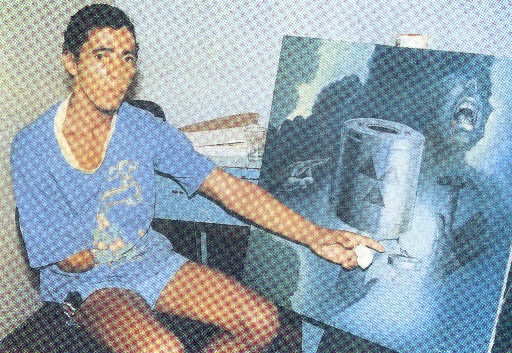1. A Glittering Powder
Mar. 25, 2013
Chapter 6: Brazil and Namibia
Part 1: Cesium Contamination in Goiânia
Part 1: Cesium Contamination in Goiânia
In September 1987, a cylinder containing cesium-137, a radioactive substance used in medical equipment, was removed from an abandoned hospital in Goiânia, central Brazil. As a result, over two hundred people were exposed to radiation. Four died, and the survivors are still suffering from the tragic effects of the "glittering powder."
1. A Glittering Powder
"When we broke open the cylinder a little capsule the size of a matchbox fell out," said Robert Alves, as he pointed listlessly to a painting of the cylinder done by a local artist. We were visiting the Leide Foundation set up by the Goiás state government to help the victims of the accident in Goiânia.
It was Alves who had unwittingly caused the cesium contamination in the city. His right arm had been amputated to prevent the effects of handling the radioactive substance from spreading to the rest of his body.
On September 13, 1987, he and his friend, Wagner Ferreira, set out for an abandoned cancer hospital in search of scrap to sell. The three doctors who had originally run the hospital had moved elsewhere in 1984, and the site was overgrown with weeds. Entering the grounds, the two men saw a small concrete hut. There was no fence around it, and the lock was broken. Inside lay a white metal container.
The two young men lived from day to day never knowing where their next meal was coming from, so to them the container spelled much-needed cash. They loaded it onto their light truck and took it home, intending to dismantle and sell it. The white outer shell was easily broken, but the cylindrical container inside proved much tougher. Alves and Ferreira attacked it with hammers and screwdrivers for three days before finally succeeding in breaking it open. Unfortunately, they were unaware of the meaning of the three black triangles painted on the outside of the container.
The fruit of their labors was a small capsule which the men took along with the broken container to a scrap dealer, Devair Ferreira. In exchange they received a small amount of cash.
We attempted to interview the scrap dealer, but he refused to speak to us unless we paid him. "All the media attention has gone to his head," explained Halim Girade, director of the foundation.
According to Girade, Ferreira took a hammer to the mysterious capsule, curious to find out what was inside. It broke on impact, and a sparkling blue powder, not unlike the sequins used at carnival time, flew into the air. The dealer then proudly handed out the glittering powder to all his friends and relatives in the neighborhood, spreading contamination from house to house and person to person and causing 249 confirmed cases of exposure to high doses of radiation and the loss of four lives. As a result of the careless disposal of four ounces of cesium-137, combined with the multiplying effects of poverty and lack of education, the lives of Robert Alves and the others exposed to the "glittering powder" will never be the same again.








